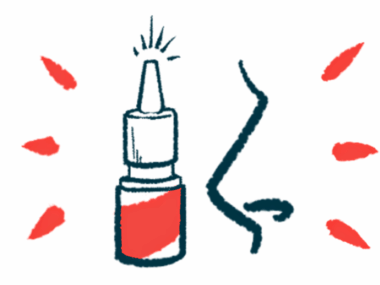Tysabri Shows Safety, Effectiveness in Real-world RRMS Use: 10-year TOP Data
Written by |

Tysabri (natalizumab) is safe and shows robust, real-world effectiveness at reducing the frequency of relapses in people with relapsing-remitting multiple sclerosis (RRMS), 10 years of data from a large, observational study report.
Findings were reported in “Long-term safety and effectiveness of natalizumab treatment in clinical practice: 10 years of real-world data from the Tysabri Observational Program (TOP),” a study published in the Journal of Neurology, Neurosurgery & Psychiatry.
Natalizumab (brand name Tysabri, by Biogen) is an antibody-based therapy that works to ease inflammation in RRMS patients by preventing immune cells from entering the brain. Several clinical trials and real-world studies have found Tysabri to be highly efficacious in treating RRMS, leading to its approval in both the U.S. and EU.
The Tysabri Observational Program (TOP; NCT00493298), which began more than 10 years ago, is the largest ongoing study of Tysabri’s use by RRMS patients. Following people for up to 15 years, it gathers effectiveness and safety data on those who started treatment with Tysabri in routine clinical practice.
Five-year interim TOP data, covering 4,821 patients, showed that Tysabri consistently reduced the rate of relapses and disability in RRMS patients, with no new safety concerns reported.
Investigators here reported 10-year interim data from the study, extending “the previous five-year interim analysis with a larger population [1,327 more people] and longer duration of natalizumab exposure [eight or more years].”
They also evaluated the potential impact of attrition bias on data supporting effectiveness, comparing results from a group of patients who remained on Tysabri for at least eight years to findings among those who stopped using it before that timepoint. (Attrition bias refers to an unequal loss of members within different groups in a trial that causes an imbalance — a bias in findings about those groups.)
Analyses focused on assessing the annualized relapse rates (ARRs), and disability progression — using the Expanded Disability Status Scale (EDSS) — in those who remained on Tysabri over the entire course of the study and in those who stopped treatment but continued being monitored within TOP.
Between July 2007 and Nov. 1, 2017, a total of 6,148 RRMS patients from 17 most European countries were enrolled in TOP (mean age at baseline, or study start, 37.1), and using Tysabri for a median of 3.3 years.
More than half (52.8%) had an EDSS score greater than 3.0, indicative of moderate disability; nearly all (84.5%) had used another disease-modifying treatment (DMT) before starting with Tysabri.
Safety analyses revealed that 829 patients (13.5%) experienced at least one serious adverse event (SAE), and 290 (4.7%) had a SAE that was deemed related or possibly related to Tysabri. The most common SAEs reported in TOP included infections (4.1%), followed by nervous system manifestations (2.3%), and immune system disorders (1.5%).
“Over the course of natalizumab treatment, >85% of patients had no SAEs. In those patients who did experience an SAE, infection was the most reported SAE … Opportunistic infections other than PML were reported in a very small proportion of patients (0.2%), which is consistent with the rate of <1% observed in clinical trials,” the researchers wrote.
More than half (52.2%) of the patients discontinued treatment with Tysabri, and approximately a third (34.4%) withdrew from TOP. The most common reasons for treatment discontinuation were positive anti-JCV antibody status (46.3%), patient decision (25.9%), and medication change (19.2%).
“[L]ack of efficacy was rarely given as the reason for natalizumab discontinuation,” the researchers noted.
JCV (John Cunningham virus) infection causes progressive damage and/or inflammation at multiple sites in the brain, and can trigger a rare and often fatal condition called progressive multifocal leukoencephalopathy (PML).
A total of 53 patients (0.9%) had confirmed PML. In general, these findings were consistent with Tysabri’s known safety profile. No new safety concerns were reported during the study.
“Of the 53 confirmed cases, 36 (67.9%) occurred in patients receiving natalizumab for >3 years and 14 (26.4%) occurred in patients reporting prior immunosuppressant use. Of the 36 cases with reported anti-JCV antibody serostatus 6 months prior to PML development, 35 were positive,” the study noted. “These results are in line with the current understanding of the risk factors for PML (duration of treatment, prior immunosuppressant use and the presence of anti-JCV antibodies).”
Effectiveness analyses showed a drop in ARR from 1.99 the year before starting treatment with Tysabri to 0.15 while on Tysabri, corresponding to a reduction of 92.5% in the frequency of MS relapses. AARs while on Tysabri were similar for patients who remained on the medication and for those who discontinued treatment, indicating limited attrition bias in these findings.
Over the course of a 10-year follow-up, the cumulative probability of disability worsening was 27.8%, and the cumulative probability of disability improvement was 33.1%. Disability worsening was defined as an increase of more than 0.5 points in a patient’s EDSS scores since baseline; improvement was defined as a more than 1.0 point drop in EDSS scores since baseline.
Tysabri-treated patients “exhibited significant disease control over the course of the study, as evidenced by on-natalizumab ARRs that were reduced and remained low, and EDSS scores that remained stable over 10 years,” the researchers wrote, summarizing overall findings.
“This 10-year interim analysis further supports the robust real-world effectiveness and well-established safety profile of natalizumab,” the team concluded.
“The planned continued follow-up of TOP patients for up to 15 years will provide further data on real-world outcomes in natalizumab-treated patients,” they added.





